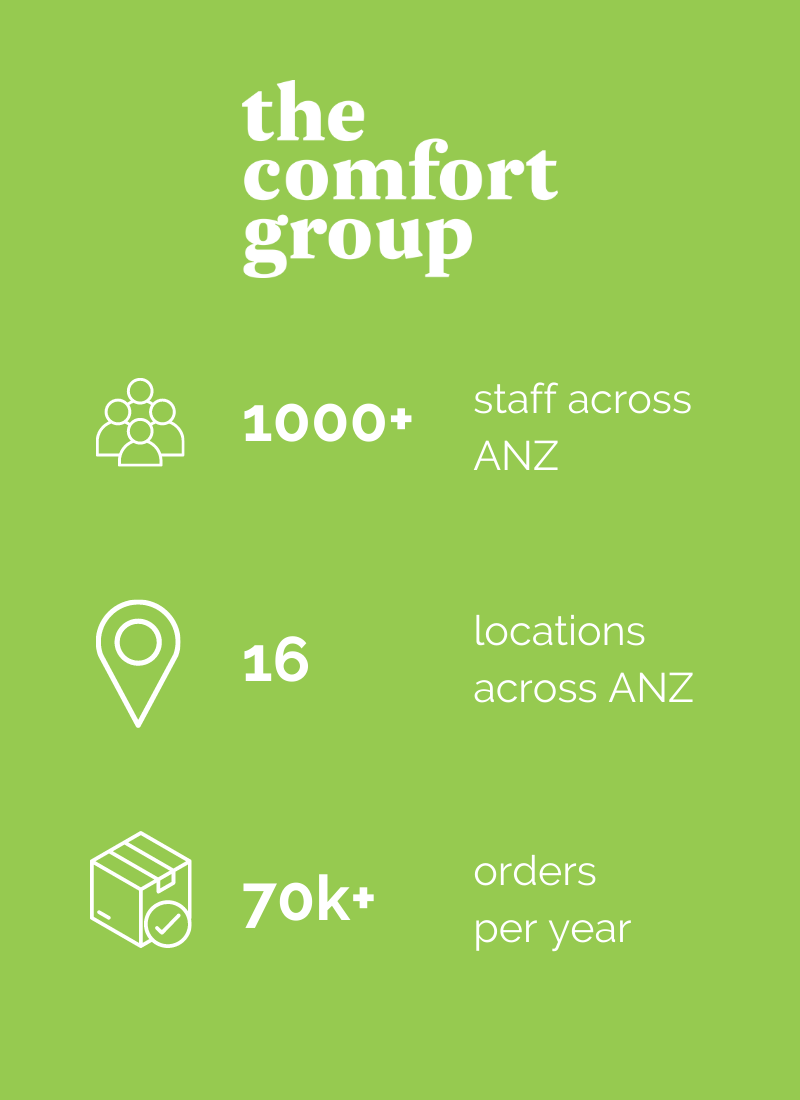EDI RESULTS IN HAPPIER CUSTOMERS AND FASTER DELIVERY AT THE COMFORT GROUP.
CHALLENGE
The Comfort Group is Australasia’s largest mattress and foam manufacturer, with multiple manufacturing locations across New Zealand and Australia and more than 1000 employees. Its traditional model has been build-to-order, with orders from retailers being scheduled for production rather than being supplied from inventory.
Efficient planning, manufacture and delivery relies on orders being processed into the company’s ERP system quickly, so that delivery times can be accurately provided to customers. But with complex BOM data for orders and order taking being heavily skewed towards the weekend, manual data input created a bottleneck that was adding as much as a full day to the planning process.
The company had previously built a custom EDI solution to service a small number of customers, but it was difficult to add new customers to this. It needed an EDI solution that could streamline the whole process, smoothing out the Monday morning data bottleneck while dealing with differences in individual customer needs.

SOLUTION
A WELL-INTEGRATED EDI SOLUTION
A WELL-INTEGRATED EDI SOLUTION
The Comfort Group searched for a better solution and settled on Flow Software. With a growing number of Australian customers keen to implement an EDI solution, The Comfort Group needed an EDI solution that would let them interface with various different customer systems and its own legacy ERP system. EDI solutions with its customers vary from reasonably simple for clients using S4/HANA to comparatively complex for customers using older or custom solutions. But whatever the connection, Flow provides the glue, enabling the passage of crucial order information between customer, ERP system and back again.
Flow worked with The Comfort Group to negotiate its customers’ specific requirements, with each customer having differences in the business logic they apply to transactions. At the same time Flow manages internally the business rules around the complex BOM data that comes with its build-on-demand and custom configuration model, ensuring that the correct order details are always passed through to planning. Critically, Flow scales to handle the weekend data surge, providing an EDI solution that ensures the time between the customer placing an order and that order going into the production process is minimised no matter how busy the weekend sales have been.
“Twice a day customer services had to go back and check all the orders they’ve keyed in to make sure they were correct. Now, with Flow, we’ve removed large customers and the volume of orders they sent through from that process. It’s a big win”
RESULTS
TIME SAVED AND ERRORS REDUCED
TIME SAVED AND ERRORS REDUCED
For The Comfort Group, its largest customers were those most keen to enable EDI which meant the business benefits in time saved and errors reduced from switching from manual order entry to full EDI were significant.
Simon Davies, Product Owner at The Comfort Group, Asia Pacific, says that prior to implementing EDI, the need for manual order entry caused delays in orders entering the production queue and could lead to lost customers. Also, errors in data entry could impact delivery further down the line when the error went unnoticed and the wrong product was produced and potentially delivered.
Since the introduction of EDI, the AR team are no longer enveloping the largest customers’ invoices and sending them out each day. Additionally, due to the controls in place around ASNs, the credits have dramatically reduced as the orders no longer have mistakes. A significant improvement for the AR team and the customers’ AP teams.
FASTER DELIVERY, HAPPIER CUSTOMERS
FASTER DELIVERY, HAPPIER CUSTOMERS
According to Simon Davies, EDI has improved the production process immensely, with orders immediately available to both customer services and planners. The downstream effect from greater accuracy and speed at the very start of the process is significant, leading to faster delivery times, and happier customers.
And there are many other benefits, such as the reduction in paper consumption and the fact that the customer service team is able to focus on building relationships with customers rather than keying in orders.




